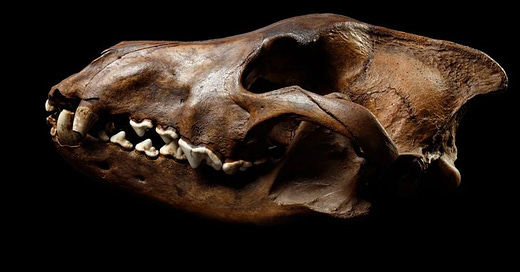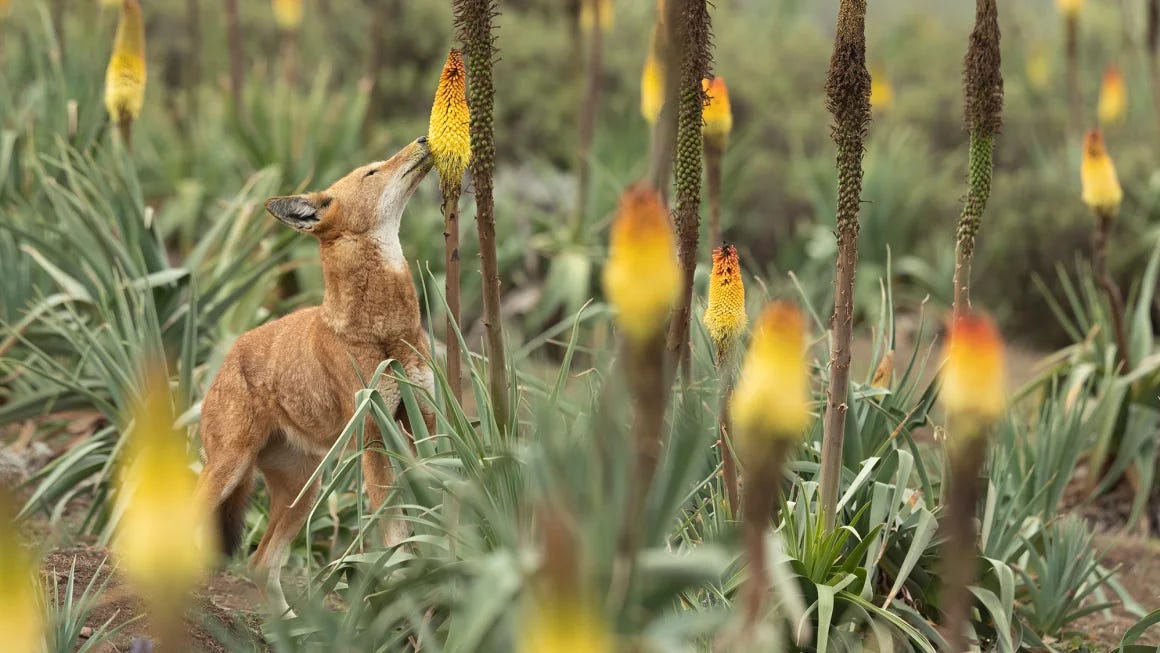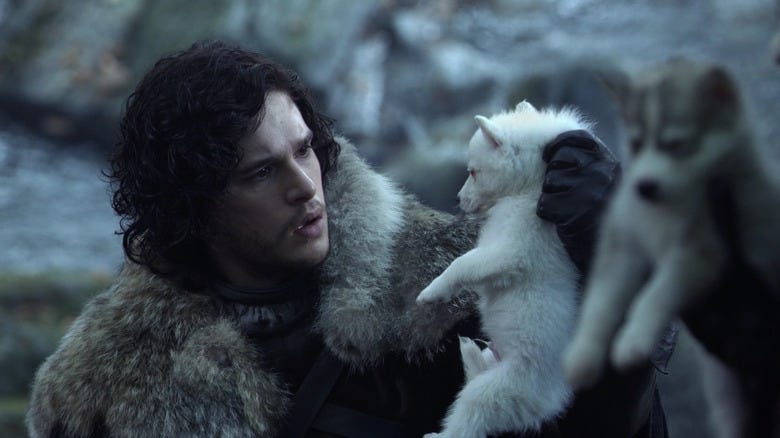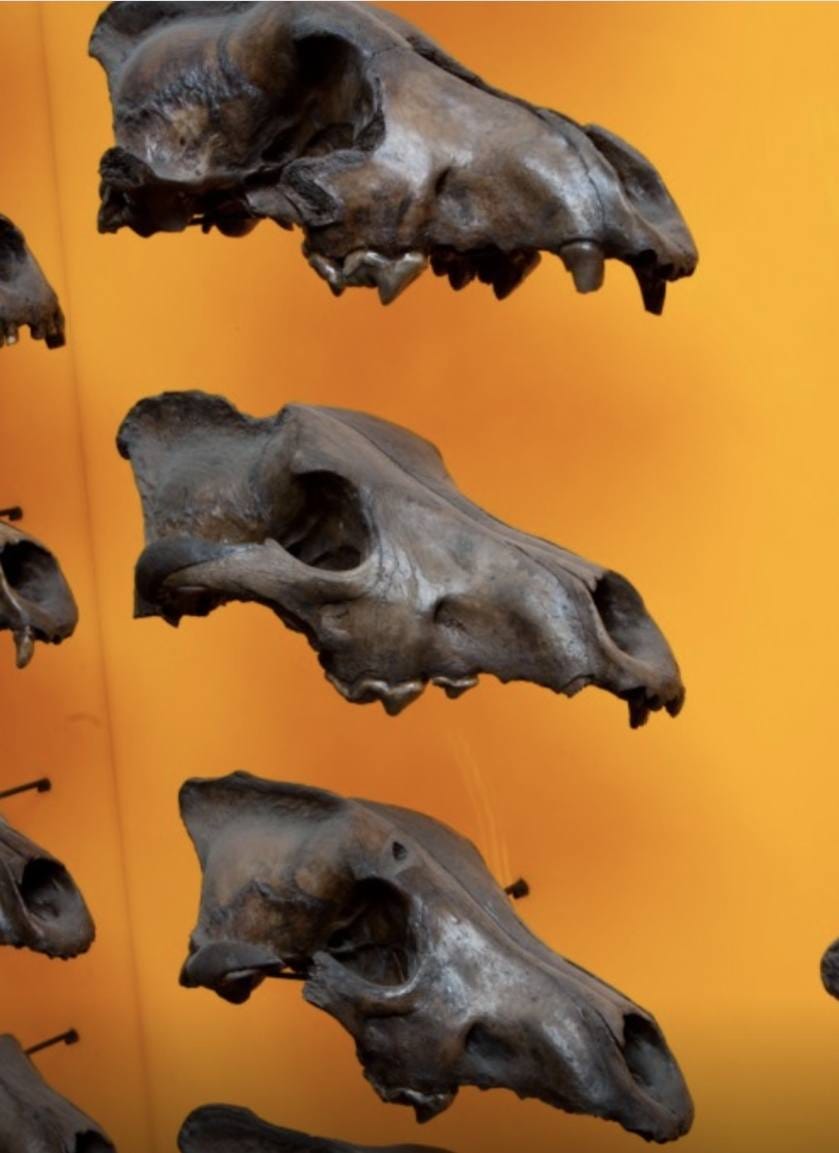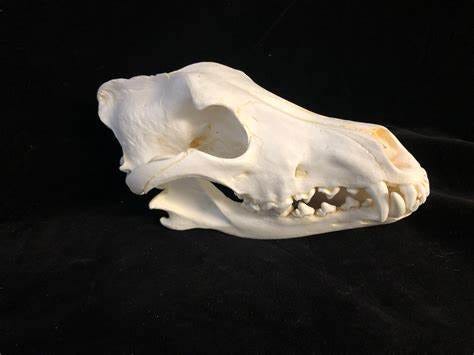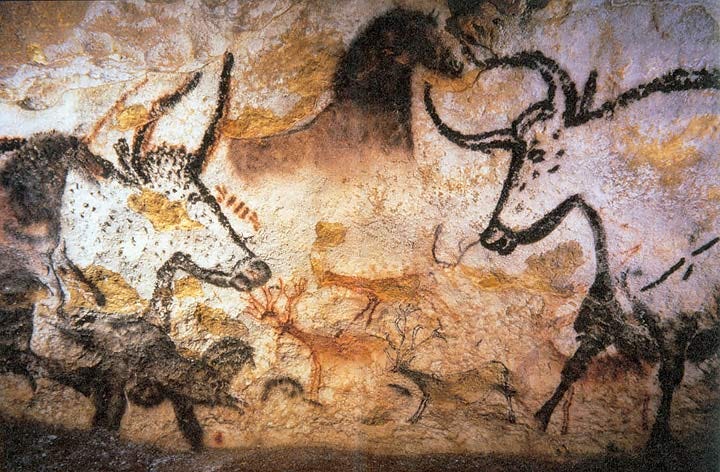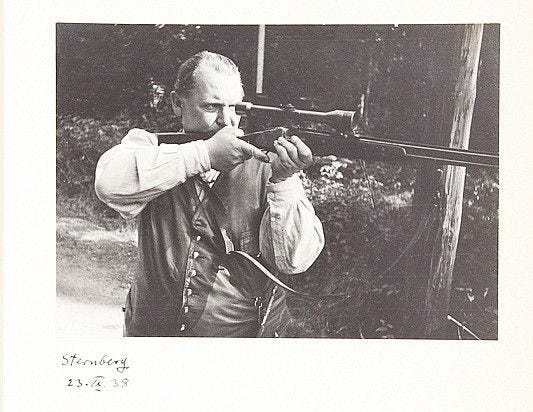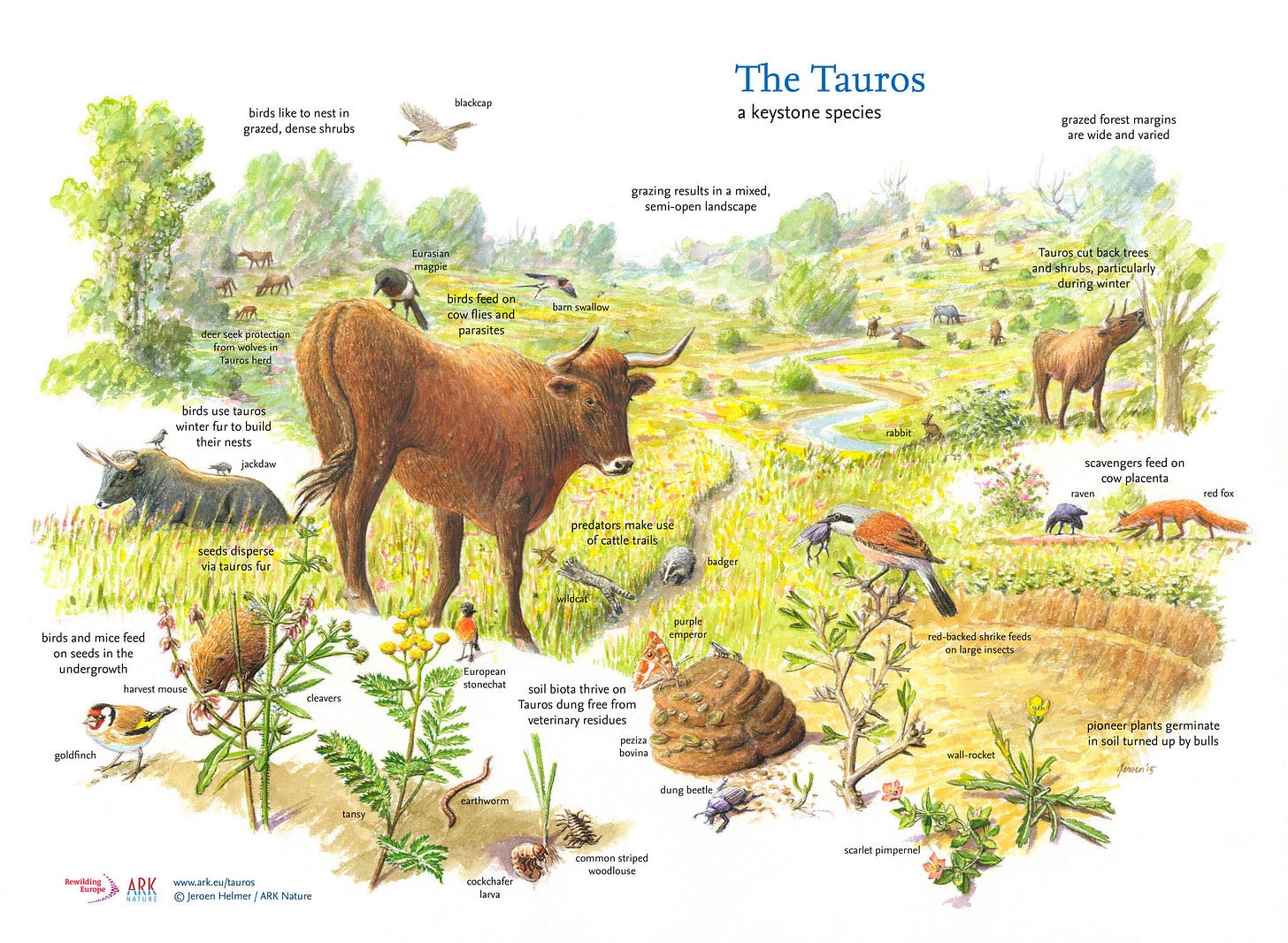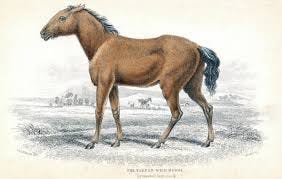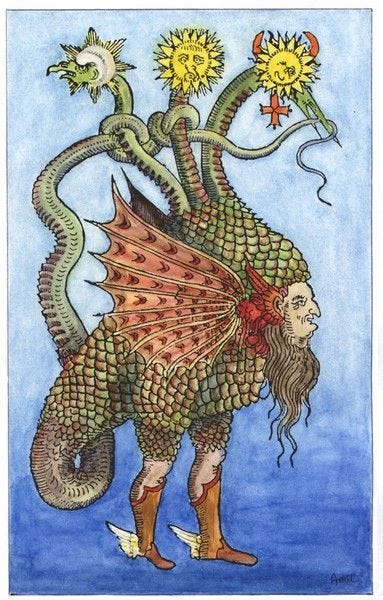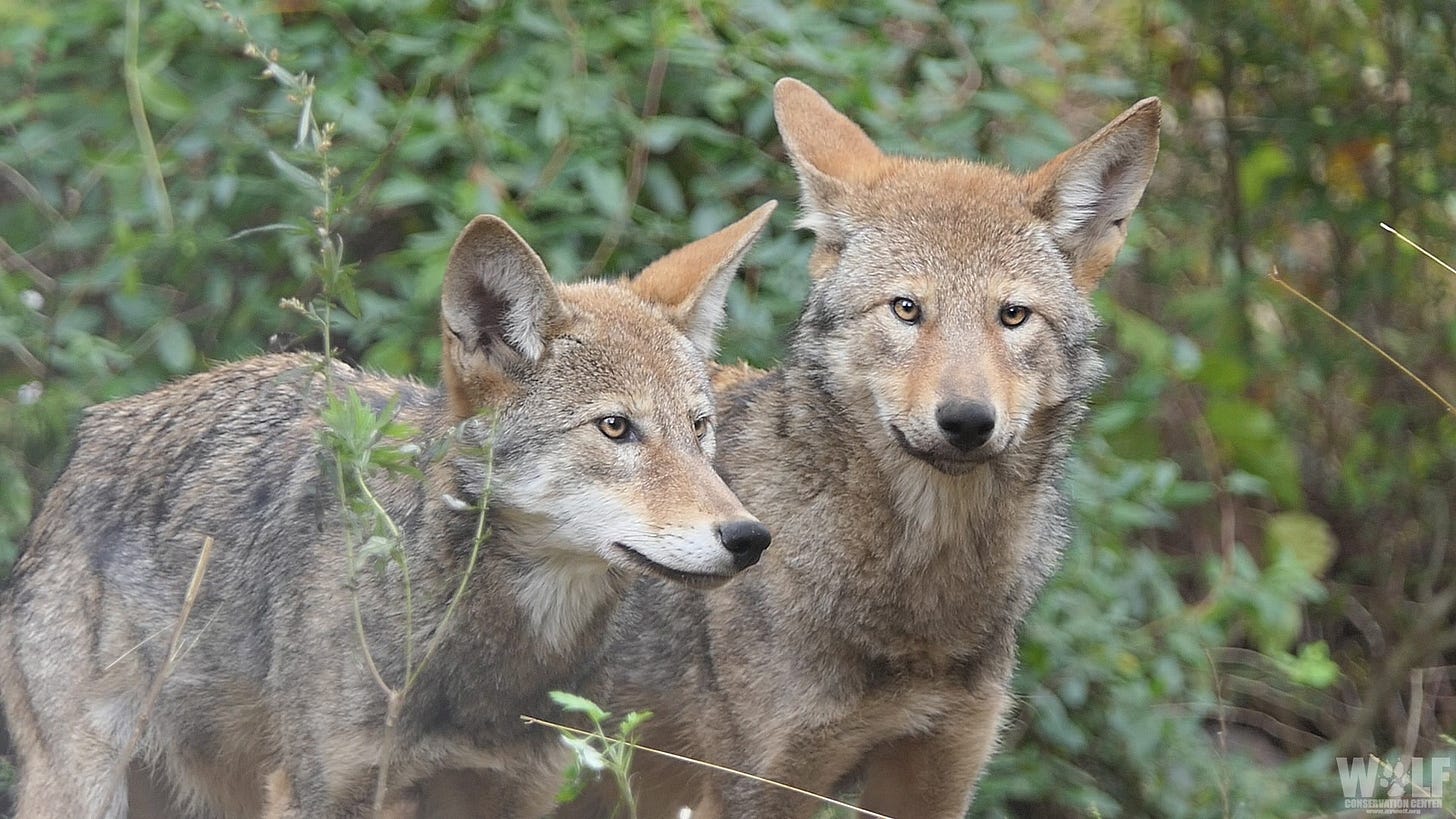Hecking Faux-na Hacking Headlines
Bamboozled again! Those cute little floofs aren't dire wolf puppies, and this is not the first faunal flimflam.
Dire wolf skull in the La Brea Tar Pits & Museum collection.
Here, In the Groves of Symbols, I don’t typically react to current events. Myths, legends, art, magic and language are the usual order of the day. But you know I’m obsessed with wolves, and I couldn’t help responding to the flood of news headlines heralding the “de-extinction” of the dire wolf.
Corrections to the first barrage of hype are now reaching the public, but I wanted to blog about this because I have long been interested in other faux-na species that aren’t in the headlines at the moment, and in animals’ entanglements with authoritarian regimes.
Not A (Dire)Wolf
The above image is the profile photo for Dan Sheehan’s Not A Wolf (Sick of Wolves) comedy page.1 He makes sure to tell us again and again that he is not a wolf, and I’m going to tell you — if you haven’t heard it already — that dire wolves are also not wolves.
Dire wolves went extinct at the end of the Pleistocene era, 10-12,000 years ago during the Quaternary Extinction Event. This was a period that also saw the demise of number of other large North American fauna, including the stag-moose, shrub-ox, and various native bison, horse, and camel species, (etc.)
Probably, the reason the dire wolves couldn’t survive was climate change made their large prey scarce or extinct, and they had difficulty outcompeting other predators — such as grey wolves — in chasing smaller quarry.
For more than a hundred years, scientists assumed that grey wolves were their closest living relations, on the basis of morphological characteristics (features such as bones and teeth). However, while dire wolves did live alongside North American grey wolves and coyotes, there is no evidence that they ever interbred or exchanged genes. According to experts at the La Brea research center in Los Angeles, their ancestral lines may have diverged nearly 6 million years ago, branching out of the archaeic Canis lepophagis into lines that would develop into coyotes and dire wolves on one side, and red and grey wolves (and dogs) on the other.
These separate lineages evolved in isolation from one another, and the first dire wolves arrived in the Americas only 125,000 years ago — quite recently! While other canids can mix and match, wolves and dire wolves probably could not have interbred even if someone cooked up a very potent love potion. Perhaps its inability to breed with its more nimble canid cousins contributed to the archaic predator’s demise.
So you get the point: dire wolves, Aeonocyon dirus (“dire, terrible dog”), are not just XXXL wolves.2 This is why taxonomists reclassified them from Canis dirus into a separate genus. If we’re seeking a present-day surviving cousin, the misnamed dire “wolves” are, in fact, more closely related to African jackals and Ethiopian wolves.
Above: an Ethiopian wolf licking sweet nectar from red hot poker plants. In addition to being predators, they are a pollinator species. Source: CNN: “Wolves May Be Pollinators As Well As Predators, Study Suggests”.
Because they are so distantly related to grey wolves, real dire wolves did not look much like Nymeria, Lady, Shaggydog, Grey Wind, Ghost, and Summer from Game of Thrones, or even giant Malamutes. Instead, they probably resembled giant foxes, according to Angela Perri, an archaeologist at Durham University.
Jon Snow and Ghost from a Game of Thrones still. Slashfilm.
In a massive publicity stunt this Monday (April 8), the biotech company Colossal Biosciences brought forward their claim of making dire wolves “de-extinct” using a new synthetic technology. This consisted of extracting DNA from a 13,000 year old fossilized tooth and a 72,000 year old skull, then, using CRISPR gene-editing technology and cloning, they turned their DNA specimens into puppy embryos, which were implanted in a surrogate mother dog.
Among the thousands of genes that differ between the dire wolf and grey wolf, Colossal selected a mere 20 changes — and proclaimed success in resurrecting the extinct animal.
Their focus, needless to say, was on some of the most showy, superphysical aspects of morphology (fur color and thickness, head shape, size). The kind of exterior traits that will photograph well. Now, they are sharing images of their puppies Romulus, Remus, and Khaleesi, who were born in October, 2024:
Yes, I want to boop those little snoots and snuggle them while they practice howling — very badly! Source: Colossal's own hype. But — did dire wolves howl? Or did they yip like foxes and coyotes?
There are some pretty serious ethical issues with what this company has done. The first two have to do with misrepresentation. Genetically altered grey wolves are not dire wolves! The second flimflam is the notion that DNA of such ancient provenance extracted from fossilized remains is still viable, when (at least at present) it is not. Most of the material is too degraded and damaged to biologically copy or clone, so a full, faithful copy of the dire wolf’s genes is probably impossible to access. The same is likely true of other long-extinct species, which means if this project builds momentum for Colossal, they will go on making the same misrepresentations — and making bank with them.
"Ancient DNA is like if you put fresh DNA in a 500 degree oven overnight," Dr Rawlence told BBC News. "It comes out fragmented - like shards and dust.
"You can reconstruct [it], but it's not good enough to do anything else with."3
Dire wolf skulls, from the La Brea exhibition. More than 4000 of them have been excavated from the tar pits. Compare them with the grey wolf skull below:
Sue Ann McCarty, an archaeologist who specializes in faunal remains, points out that the sagittal crest (ridge on top of the skull) and the slope of the nose on this skull are quite different than in the dire wolf skulls.
Two grey wolves (lower left) confront a pack of dire wolves over a bison carcass in Southwestern North America 15,000 years ago. Picture credit to Mauricio Anton, available to view here in the article “Ancient DNA Reveals Secrets of the “Terrifying” Dire Wolf – Famous From Game of Thrones”.
The third problem has to do with the animals’ quality of life, with all that implies for them, and, potentially, for other species. The Colossal Biotech pack of franchise-ready gene chimeras are forced to eat diets that cannot match dire wolves’ ancestral fare of extinct megafauna. This may affect their balances of microflora that can impact their guts, brains, immune systems, and overall health in ways that cannot be compared with living specimens. If large numbers were released into the wild, what could the knock-on effects possibly be?
This is where the question of why are we really doing this comes in. Is it just to raise more venture capital? For publicity? For curiosity’s sake? Do these faux dire wolves deserve our compassion, or is it better directed toward the more than 110 million mice, rats, frogs, dogs, cats, rabbits, hamsters, guinea pigs, monkeys, fish, and birds that are killed for scientific and consumer purposes in U.S. laboratories for chemical, drug, food, and cosmetics testing, and elsewhere for biology lessons, medical training, and curiosity-driven experimentation?
In the abstract, the question is unanswerable, but concretely there is no doubt that the experimentation will continue, since hyping up faux-na already has a long tradition.
Indeed, this is not even the first attempt at bringing back dire wolves. The first effort was called the Dire Wolf Project. (Here is their scammy-looking website.) Their methodology consisted in backbreeding domestic dogs, an unscientific method that has been used with Heck cattle and other aurochs programs, and another project that tried to revive the quagga.
The First Hecking Bamboozle: Faux Aurochs
The German brothers Lutz and Heinz Heck, were sons of the director of the Berlin Zoo. These two zoologists attempted to revive aurochs (Bos primigenius), an ancestor of the bovid family, in the 1920s. This animal is famous from cave paintings, and was hunted to extinction in Poland in the early 17th century.
Painting from Lascaux Cave, France, with aurochs, horses, and deer. Wikimedia.
The Hecks had no knowledge of genetics (DNA) as we understand today, but they had been raised in an environment where a lot of animal breeding was taking place. And, importantly, zoologists around Europe were actively discussing how humans could prevent extinction in the early twentieth century. It was thought by many that zoos could play an important role in all of these projects. Simultaneously, many were also FAFO creating new hybrids (ligers, tions … )
Lutz Heck with a scaly anteater, 1940. Smithsonian. He looks a little creepy — I’ll tell you why in a minute.
The Heck brothers wanted to preserve the endangered wisent (European bison) but also to take conservation one step farther by bringing back the extinct aurochs. They reasoned that if modern cattle were descended from the aurochs, they could just bring the right traits back together, like fitting pieces into a puzzle. Their work consisted in traveling around Europe and selecting cattle that they thought would create the right form, and therefore functions for their aurochs: Spanish fighting bulls were chosen for their size; Corsican cattle were chosen for their color; and Camargue cattle had nice big horns. Over the course of eleven years, they bred all of these (and more) as they tinkered to get the animals’ appearance right. They ended up with an animal that has an aggressive temperament (thanks to those Spanish bulls), a taste for independent living, and some genetic weaknesses.
Above: Heck cattle. Source. Not bad, right? But …
Supporters of the breed claim that Heck cattle look very similar to aurochs, critics point out differences in height, build, and proportions, with some adding that other cattle breeds resemble aurochs as much or more than Heck cattle. The other criticism is that a wide range of phenotypes exist within the breed; i.e., it is not at all stabilized.
Creator: D. Foidl. Source.
Do you want to know a bigger secret about the Heck brothers and their fake aurochs? They were funded by the Nazis.
According to Lorraine Boisonneault writing for Smithsonian Magazine,
despite their shared interest in zoology and animal husbandry, the brothers’ paths diverged greatly as the Nazis rose to power. In the early 1930s, Heinz was among the first people interned at Dachau as a political prisoner for suspected membership in the Communist Party and his brief marriage to a Jewish woman. Though Heinz was released, it was clear he would never be a great beneficiary of Nazi rule, nor did he seem to support their ideology focused on the purity of nature and the environment.
Lutz joined the Nazi Party early in its reign, and earned himself a powerful ally: Hermann Göring, Adolf Hilter’s second-in-command. The two men bonded over a shared interest in hunting and recreating ancestral German landscapes.
Reviving the aurochs with an exclusive patent from their zoologist friends would supply the Reich with a potent symbol of ancient racial “purity.” They saw this as a sign that Europe’s heroic and mythical past could again be touched, killed, eaten, and displayed — by their elite. The Nazis were funny that way: while on the one hand they espoused modernity and rationality, the yin to that yang was a kind of anti-Enlightenment romance with tradition, mysticism, and blood-and-soil cultural essentialism.
Hermann Göring “had a very peculiar interest in living a kind of fantasy of carrying spears and wearing peculiar dress,” which resulted in him seizing part of Poland’s Białowieża Forest, where he created personal hunting preserves — his own private version of Lebensraum (living space). There, he lived out his fantasies of being a heroic hunter from an imagined mythic age of yore — and even recreate scenes from the epic poem Nibelungenlied, where the hero Siegfried kills all kinds of wild creatures in the forest. Source.
The Hecks supplied this Teutonic Nimrod4 with “aurochs,” and also their versions of wisent and Tarpan horses (which I will discuss below).
Hermann Göring hunting. Photograph from a “presentation album” gifted to him by his friend Lutz Heck. Source.
There are some 2000 Heck cattle still living in Europe today. They are descendants of the few that survived when Allied forces killed free-ranging animals as they as took control of territory at the end of the war. The cattle are still displayed in German zoos and — among other places — in the outdoor museum and learning center in the Neanderthal, Germany, where I saw their enclosures. (The animals, unfortunately, were nowhere to be seen near where visitors can view them, as they are quite shy, so I just saw the educational plaques, metal silhouette cutouts, and some manure.)
The Heck brothers had claimed that, since they they had brought back the aurochs, their cattle should be used in conservation projects, and their crossbreeding approach eventually inspired Rewilding Europe and the Taurus project with similar ideas. It is, admittedly, a compelling vision, but I am curious about the arrangements proposed for ownership of the land and animals. Is this going to be a hunting park available only to bigwigs like Göring, or to a corporate elite? And I am also interested to know more about how they plan to handle predation from other “keystone species” that are — strangely — missing from this picture. (Ehm! Wolves.)
Image from the Rewilding Europe webpage.
Oh Hecks, Bamboozled Again! The “Tarpan”
The Heck brothers thought they were on a roll with their wisent and cattle, and the next project was bringing back the tarpan, a Eurasian wild horse that became extinct in the wild in the late 19th century, due to hunting and crossbreeding with domesticated horses. The last captive specimen died in 1909 in Russia.
The brothers’ methodology was the same with the horses as it had been with the “aurochs” — they collected mares that they believed showed the strongest signs of tarpan ancestry, or at least the right physical features: Koniks, Icelandic horses, and Gotland ponies were bred with Przewalski’s Horse5 stallions. Animals from the subsequent generations were chosen according to their color, skull shape, and bone structure. However, unlike with their cattle, a stable morphology did develop in Heck horses. Source.
Heck Horse / Steppentarpan. Wikimedia.
Extinction is forever
There will be more fucking around; there will be more finding out. The human mind contains multitudes, and loves to see them roaming around in art, stories, and — if possible — in the world. Nothing wrong with that, but — always — follow the money and the sympathy and influence it buys.
Hermetic Mercury of the Tria Prima. I’m not trying to scaremonger that this is what scientists are up to — I just really like old alchemical and hermetic illustrations.
Colossal Biotech had already been in the news earlier this year with its announcement that it created "transgenetic" mice as a preliminary step toward de-extincting the woolly mammoth. (Then, naturally, everyone’s least favorite US-based Kremlin asset began ranting about the Biden administration funding studies on transgender mice.) But laffs aside, the mammoth stunt will not — by all indications — be any more genuine than what Colossal pulled off with their “dire wolves.”
Transgender, ehm! Transgenic mice with the “wly” (woolly) mutation. Researchgate/Creative Commons.
The company has made strategic partnerships with wildlife conservation groups, and other organizations, and “also believes that the new EPC cloning technique will allow them to save blood samples of existing species in a biobank as a hedge against their ever becoming endangered in the future.”6 In other words, if they play their cards right, they could end up with lucrative monopolies on chimera contracts.
All the publicity is puffing up “the world's only de-extinction company” balance sheets, which are currently estimated at a value of 10.2 billion dollars. Is Colossal doing something good with their madcap experiments? Probably — perhaps, for instance, their techniques could be used to diversity the DNA of species that are threatened and have limited breeding pools.7
So why does it matter to call out the misrepresentations and excess hype, even if we might (cautiously, with fear and compassion for the new animals) support some of what Colossal is doing? The first reason, as paleogeneticist Nic Rawlence put it, is it blurs the difference between true extinction and fake “de-extinction” demotivates us to learn from our mistakes. “Is the message now that we can go and destroy the environment and that animals can go extinct, but we can bring them back?" he asks.
If push came to shove, I would rather see public and governmental support given to more worthy conservation programs — programs that protect animals and educate the public about why they matter.
As Closer to the Edge pointed out, grey wolves are still under threat [as are red wolves] and there is a real chance that Congress will strip their protections.
… while biotech millionaires reimagine the Ice Age for clicks and clout, the wolves we already have are being hunted to death.
But sure. Let’s bring back dire wolves.
Because nothing says "conservation" like resurrecting creatures we helped destroy … while failing to protect the ones still hanging on.
Joey Hinton, the senior research scientist at the Wolf Conservation Center in NY State, tells us that the leading threat to red wolf survival is human-caused mortality – vehicle collisions and shooting deaths. He emphasizes that cloning and other biotechnology cannot protect red wolves from cars or bullets, nor do they increase human empathy for these creatures.8
And we, in the meantime, what are we doing about this?
Red wolves from the NYWolf website. Please consider donating to support their research and conservation efforts.
I think I’ll share an old article I wrote about the entanglement of the Nazi regime with native European honeybees as a follow-up to this piece. Then maybe I’ll say more about Czechoslovakian wolfdogs, who featured in my recently published story "Lupercalia".
Stay tuned, and please subscribe!
Da Sheehan also has book titled I Am Not A Wolf book, published by Simon & Schuster.
How big? Approximately 3.5 feet tall, 6 feet in length, and 150 lbs. (107 cm x 182 cm, 68kg.)
Oh lawd, he comin’!
But some wolves were even larger: the Kenai Peninsula wolf (Canis lupus alces) of Alaska were the largest grey wolves the world had ever seen.
They were killed to the last one by greedy and stupid humans hunting and poisoning them during the Klondike Gold Rush, which started in the 1890s.
They were even bigger than dire wolves, and some weighed as much as 250 pounds and were seven feet in length. Source.
When I was a child, and an avid watcher of Bugs Bunny cartoons, I thought “nimrod” meant “idiot” because this is how Bugs mocked the hunter Elmer Fudd, who was a clumsy simpleton. However, Nimrod was originally a figure from the Bible, a king who enjoyed hunting. I’m using it both ways here: Göring wasn’t stupid, but he was committed to doing evil to other human beings, bedeviled by addictions to morphine and tacky costumes, and had a long record of making terrible decisions.
A caricature drawn by Arthur Szyk of the larger-than-life Göring wearing extravagant garb. Source.
So, are Przewalski’s Horses the real deal — an ancient, ancestral species living its intended lifestyle? See this discussion on Wikipedia:
Przewalski's horse was long considered the only remaining truly wild horse, in contrast with the American mustang and the Australian brumby, which are instead feral horses descended from domesticated animals. That status was called into question when domestic horses of the 5,000-year-old Botai culture of Central Asia were found to be more closely related to Przewalski's horses than to E. f. caballus. The study raised the possibility that modern Przewalski's horses could be the feral descendants of the domestic Botai horses. However, it remains possible that both the Botai horses and the modern Przewalski's horses descend separately from the same ancient wild Przewalski's horse population. Its taxonomic position is still debated, with some taxonomists treating Przewalski's horse as a species, E. przewalskii, others as a subspecies of wild horse (E. ferus przewalskii), or a variety of the domesticated horse (E. caballus).
[ … ]
The Prague Zoo launched a project called Return of the Wild Horses in 2011 With the support of public and many strategic partners, yearly transports of captive-bred horses into the Great Gobi B Strictly Protected Area continued as of 2011, an estimated total of almost 400 horses existed in three free-ranging populations in the wild. Prague Zoo has transported horses to Mongolia in several rounds in cooperation with partners (Czech Air Force, European Breeding Programme for Przewalski's Horses, Association pour le cheval de Przewalski: Takh, Czech Development Agency, Czech Embassy in Mongolia, and others). The zoo has the longest uninterrupted history of breeding Przewalski's horses in the world and keeps the studbook of this species.
Source: Time Magazine. I beg you, take this article with a huge chunk of salt and don’t share it with anyone who you think is naive enough to believe Colossal’s claims.
I would like to thank my friend Pinar Sa for pointing this out.
Here are some more of Hinton’s remarks:
In addition to the 16 Red Wolves in the wild, there are currently 270 Red Wolves in captivity that are waiting to be released to the wild. They represent the historical Red Wolf, which resulted from thousands of years of natural selection. They reproduce naturally in captivity and in the wild – we don’t need to clone them. It is limited captive space that prevents the population from increasing and improving genetic diversity. Resolving this requires a community to care for these animals, and the Wolf Conservation Center works to identify new partners to join the red wolf community.
The cloned “Red Wolves” are not Red Wolves. They were derived from coyotes captured in southwest Louisiana for the Gulf Coast Canid Project. I know these were coyotes because I served as field supervisor and captured 44 coyotes for the project during 2021–2022. Several of the coyotes that I captured in 2022 may have served as donors for cloning.

